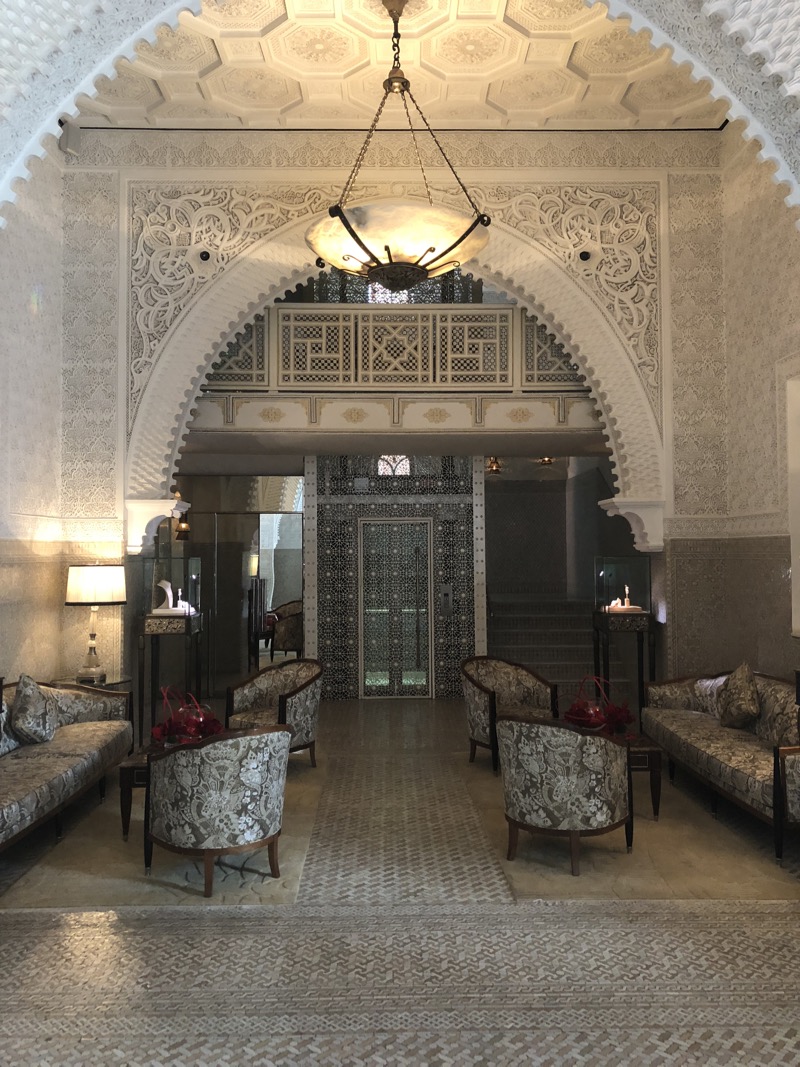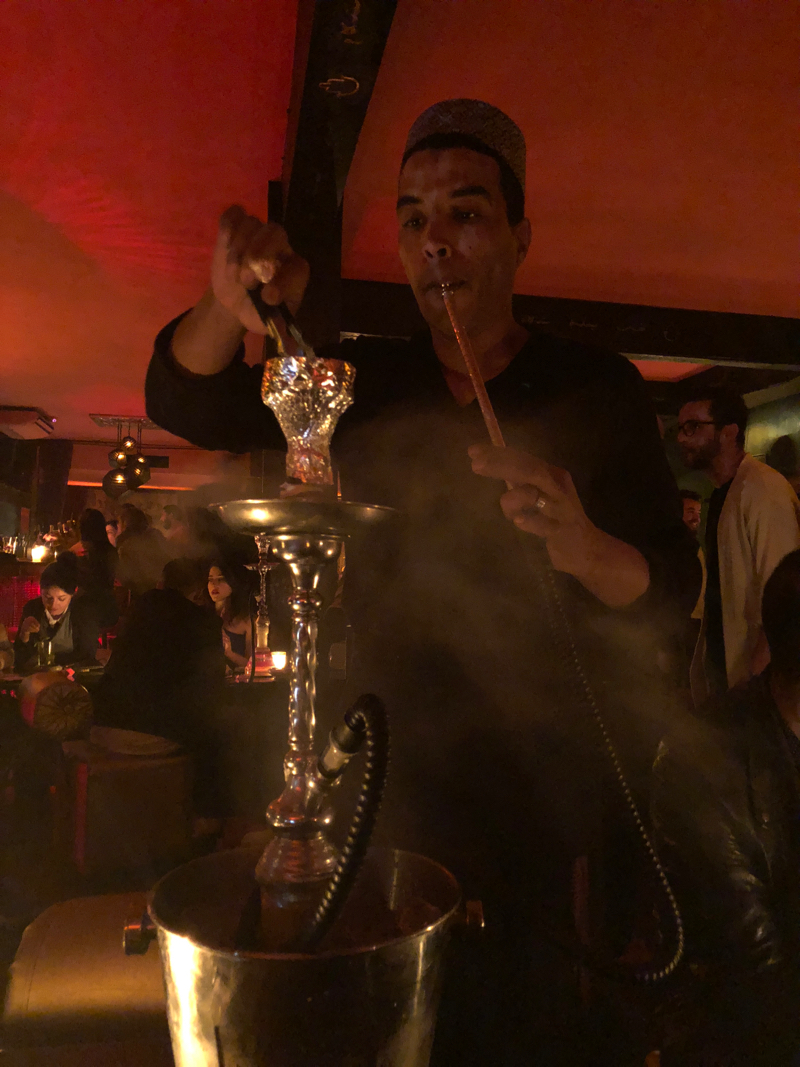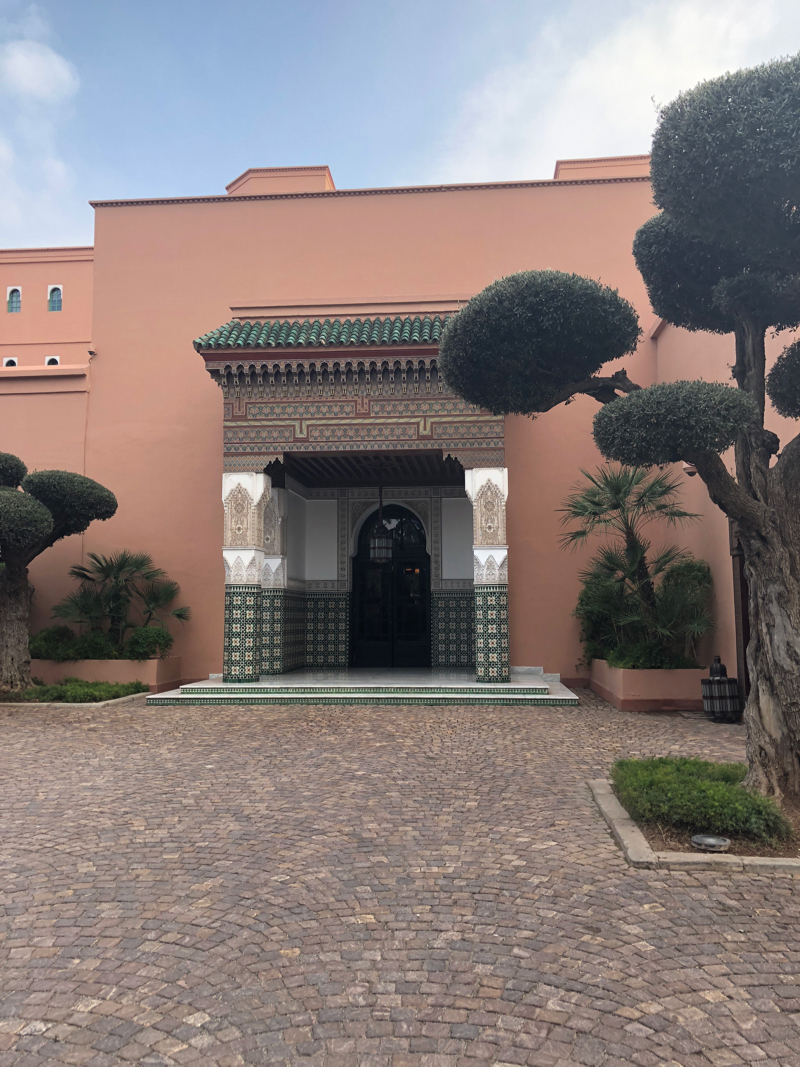Lifestyle in the bohemian Marrakesh now
Marrakesh also known as Marrakech by the French has by far the nicest airport in Morocco, world-class conference facilities, and superb quality accommodation fit for all budgets. The ochre oasis in the desert is not the capital, not even the largest urban sprawl, but the king and his family live here, and the ruler Mohammed VI leads its sustainably-tuned development and progress. The affluent got a great deal in Marrakesh, while the poor majority dresses well, and a small baksheesh offered by the good Muslims buys high quality, unprocessed street food. Palatial gated domaines in La Palmeraie house crafty villas of the Arabian royalty, Western celebrities and jet-setting designers of the new millennium. The exceptional quality of artisanship, affordability, openness and safety lure new residents in. Ambition rules in Marrakesh today, but you can still feel the artisan bohemian soul that has attracted its greatest fans over the course of its glorious centuries.
Quenching the thirst for comfort in Marrakech
Although Marrakesh is one step from the desert, it is a green city. The myriad of public gardens provide work for needy locals, while anyone enjoys their bountiful shade. Lovers date under the olive trees next to Koutoubia mosque, students roam freely the Internet in the free-for-all Cyber Park, while elderly men gossip leaning over their bikes in the sprawling Jardin de l’Agdal, and families stroll along the Hivernage olive groves stretching from La Mamounia to the square pool-centred Menara gardens.
Water, like veins, runs underground through the ancient khettara aqueducts. The liquid gold of the dessert assembles from the mountains in the manmade reservoirs dotted all over Morocco. The drenching Sahara knocks on the Moroccan South, therefore any cooling, if only mental, pampers the dwellers in the dry Arabic lands. During the unbearably hot summer with temperatures spiking above 50 degrees Celsius, indoor lifestyle is luxury. So the privileged built palaces or private riads, while the poor nested in the maze of the medina. The jews were protected by the sultan within the narrowly carved mellah clinging to the palatial walls.
The sprawling palaces are well shielded from aspiring gazes except from the birds-view. All buildings, except for the minarets, are limited to three high-ceiling floors, so one can only appreciate the largesse on a clear day from the plane or a well-set rooftop.
Marrakesh does contrasts well. In a comforting dichotomy of lemon and olive groves planted in the sand-dusted clay, the snow capped Atlas range spikes on its eastern horizon in winter. Unless you want to hike (the Ourika Valley pictured above), visit before the Easter crowds arrive and the unbearable heat of summer shuts everyone indoors. The fall is pleasant too. Beware of winter wandering as some passes and remote Berber villages can be snowed into inaccessible dwellings for months.

The fragrant oasis balances its urban chaos with countless private garden retreats. Hotels, riads (local b&b), hamams and spas are often accompanied by gardens. The most intriguing are at La Mamounia, the Royal Mansour as well as the more remote organic orchards and vegetable patches at Jnane Tamsna in the Palemeraie. If you come early, the botanical garden inside the Jardin Majorelle resuscitated by the late Yves Saint-Laurent and his partner Pierre Berger rewards with tranquil beauty. Likewise, the tiny Jardin Secret in the medina does not feel anymore like opening a poem book. Both require entry fee. Stick to your riad, the loungers of the above hotels’ private or the public gardens, and you find inner harmony.
The red city seduced plenty of creative souls into its secluded intimacy. Seeking peace in mind, here the heart connects with the brain creating beauty for all who are thirsty enough to gulp wholesomely the nectar of bliss. Like myself.

Geographically, Marrakesh reminds me of Mendoza in South America. This Argentine desert city also nests on the foothills of large mountains, and its structural make-up was inspired by its Spanish colonisers. The intellectual flow reversed in the Marrakechi architecture though since its highly embellished Moorish decorations were exported to southern Spain.
Today it stretches like a desert in the age of climate change. The drenching sprawl created poverty-stricken pockets, but also new, luxurious and secluded, palm-shaded stretches like the Palmeraie. More affordable are new apartments in central Hivernage. Sandwiched between the fancy side walls of the kasbah and the airport, this area is a practical input to the growing Marrakesh.
Early day and late night
Life in the ‘Ochre City’ ends late and starts early, and the dark window shields at luxurious dwellings and riads ensure comforts of the night owls. Before cocooning in that bohemia of Moroccan hospitality, the sun’s ticklish rays with the alarm bell of the birds’ chipper, served me a double shot of the Moroccan dawn. My under-slept face was sun-rayed through the gaps between the theatrically heavy curtains of my riad. The early messengers of the bohemian lifestyle in Marrakech teased me out.
I opened the shutters widely, longing for the sun’s warmth after a chilly desert night. Sniffing the nectars of pleasantry in the citruses, crawling bougainvillea, geranium, jasmine, rose, and honeysuckle, overwhelmed my senses with such an intense pleasure that no perfume department could match. My private Garden of Eden pacified all the usual rambling streams of thoughts. Immersed under the spell of mindfulness, countless shades of red rolled like an art movie behind my closed eyelids, while the dust of the solar powder had set deep on my skin.
One feels always close to nature in Marrakech. This chug of land scissored between the Atlantic and the Mediterranean with the desert and mountain shields is uniquely positioned to enchant, more even on the second look.



Freewheeled Marrakech
In Morocco the locals are a blend of races that passed by the strategic Westernmost islamic trade route. Here, a tolerant society, where LGBT, prostitution, and drugs like the locally grown hashish attracted the American and European creative outliers like Paul Bowles, Fitzgerald et al. Tangier’s sodomic shadows had long lost the head wind, yet today in a more law-obeying lifestyle Marrakesh hosts British designers, French artists, and free spirits from as far as Australia. The international bohemians dwell in. As yoga classes have outgrown the transport donkeys, the expats are markedly reshaping the local lifestyle. Instructed in French, English or Arabic at Yogi In Me Gueliz studio, privately with Perumal on the city’s green outskirts, yoga is the new drug.
The legendary nightlife entertains the owls at Le Comptoir, where live music, Dj spins and belly dancers swirl the human silhouettes veiled in the cigarettes and hookah smoke. Live performances are on daily program in Marrakesh at countless night venues, but the classiest of all is still the Churchill bar at La Mamounia. This Art Deco piano bar is loud – red velvet, leopard-print chairs backed by leather walls – but more lively than the most exclusive and more cosy bar at Le Royal Mansour. For sunset lounging at Le Bô & Zin, outside of the city gets the dance music loving bodies moving.



Garden Hotels in Marrakech
You can taste the fragrant nirvana whether travelling on a tight budget or are rich enough for a grande splurge. Discreet, refurbished yet authentic riads and stunning luxurious hotels accommodate comfort and mesmerise by artisanal perfection. The king owns the almost centennial La Mamounia that is impeccably preserved and the uber lavish Royal Mansour where we lodged recently. The story of La Mamounia reaches to the 12th century, yet the attached gardens gifted to Prince Al Mamoun in the 18th century made the hotel into the muse for the world’s elite artists and writers of the 1900s. Today, the modern luxury is embodied by Pierre Herme pastry parlour, Dior, YSL and other luxurious mini boutiques inside. Royal Mansour is more exclusive, lounging by its pool overlooking the nearby Koutoubia minaret, while its walled gardens bounce off any road noise. The three storey private riads with rooftop loungers and splash pools feel more luxurious than the six star Burj Al Arab in Dubai. The pastry chef treats you daily with new sweet temptation, a multi-Michelin French chef oversees the hotel’s three restaurants, and the spa facilities are the best in Morocco by a large stride. Indulge and rejuvenate in one place. At either, lush gardens grow much of the produce used at the hotel’s kitchens.
Being self-sustaining was tatooed into the nomadic predecessors mindsets. In the outskirts Jnane Tamsna and Ksar Char-Bagh also have their own herb garden and farm, with wheat for fresh bread, olive trees, and a fruit orchard.
Most luxurious hotels and most riads offer the pleasures of their own hammam, but there are also excellent public ones like Les Bains de Marrakech with branches near Paris. Lather the kessa glove and exfoliate your warmed body thoroughly for a clean, even skin, then rinse it off with buckets of warm water, and you will feel like new!
The Paris-based Jacques Garcia designed Selman hotel shows the Moroccan pride through its stable of Arabian racing horses. Some are to the guests disposal, but most are trained to trot on the nearby Royal Polo Club. The service at the boudoir-like dim hotel is shaky and the Instagram-ready 34 metre palm lined pool is too shallow to swim in, yet the private riads pamper with larger private gardens than any other hotel nearby. The Aman feels too cold, plus being next to a golf course does not feel right, the Mandarin is splendid, but you will have to be driven anywhere all the time. Its Chinese restaurant Lilly sucks, sorry.


Artisanal and locally creative shopping in Marrakech
The Marrakech medina is a treasure throve for antique hunters. Sadly, the original organisation by type of craft is being rendered over with chaotic I sell everything stores, but reliably Souk Cherifa off Rue Mouassine is a bundle of contemporary Moroccan design inside the medina. I bought well-tailored jacket, dress, pants and even evening robe at family-run La Maison du Caftan, they have traditional Moroccan pointed babooshes too. Nearby, above lively cafe Le Jardin, the Algerian Norya Ayron sells Sharon Stone’s favourite kaftans. Her colourful collections change seasonally and the light material feels great on the skin. They travel well as after Arizona, Venice beach, now I am lounging in my souvenir in Japan. Hanout fashion boutique sells unique coats, leather jackets, kaftans, pants, bags and tops. For gorgeous ethnic bags hand-stitched by local housewives from second-hand praying rugs, crochet lamps that lit the trendiest restaurants in Morocco, Marrakech inspired bijouterie, and leather backpacks seek Hamimi Design. Their bags can be purchased at the 33 Rue Majorelle concept store and café.
For eccentric fashion head to Maison ARTC. The individually expressive pieces are designed from vintage pieces by Artsi Ifrach inspired by Napoleon: ”There is a fine line between the ridiculous and the sublime”, the stylist cum designer acknowledges.


The colourful Berber life seems to be inspired by the spices, their clothes bite your eyes as the spices grab the palate with a force of flavours. Some Beber carpets can be monochromatic as well, and one of the chicest designs can be found at by appointment only Australian collaboration with local carpet business family Kulchi. La boutique Ben Rahal sells more traditional high quality handwoven rugs. Sturdy straw basket bags to carry your picnic, or market pursuits are sold all over the souks.


Beyond Moroccan cuisine in Marrakech
Moroccan cuisine (reviewed here) can bore an outsider after a couple of days. Even if the tajine stretches from the ubiquitous lamb, mouton or chicken to its vegetarian rendering, it feels all the same, saucy and soft. While open-minded cooks could be inspired by the uncommon ingredient pairings, the Francophile Morocco is still attached to its former protector.
French cuisine is good here. The former post office turned Grand Café de la Poste in Gueliz had its art deco history redesigned by Studio KO (like the YSL Museum) as a Parisian brasserie. Organic salads, gluten-free bread, doggie bags to go (much needed since their portions are Americana supersize me), and the menu changes seasonally. The chic Palace restaurant has a live singer downstairs, while on the ground level it is set for a romantic dinner of very good international cuisine. Lighter lunch is served at Le Jardin by Yannick at Royal Mansour hotel, where local businessman, trendy visitors and hotel guests rub shoulders. In a hay crust baked vegetables, creative sushi rolls, nigiri and Moroccan flatbread with dips are superb on a hot day.
AUTHENTIC LOCAL ACCOMMODATION WITH ROOFTOP VIEWS:
Although the international hotel boom in Marrakesh has landed ultra luxurious Aman, Mandarin Oriental and Four Seasons, my choices are accommodations with the most local character, that you would not find in Dubai or Hong Kong. These are retreats from the chaos of Marrakesh. From the cheapest to the fanciest.
Riad Soumia – budget riad with a hamam inside the medina. Black soap, scrubbing, rhassoul and massages with Argan oil.
Jnane Tamsna family-friendly hotel in the Palmeraie that is secluded, fairly priced, tradition meets Moorish abundant design.
L’Hotel – historic 19th century riad, where five spacious suites surround a courtyard garden and small pool in an intimate retreat. Owned by the English gay designer Jasper Conran OBE, the accent is on superb Moroccan craftsmanship, antique furniture, comforting textiles, lighting and art from his collection.
El Fenn – owned by a British gallerist Venessa Branson, in this riad contemporary Arabic art is seamlessly injected into the Moroccan cosiness guiding you to unplug from the modern urban distractions – no TVs, phones, but a fire-lit library, rooftop lounging, even a hammock settle you into the mindful joy of here and now.
La Maison Arabe – five-star traditional riad inside the medina, where historic figures resided when not at La Mamounia.
Le Riad Yasmine – the sixteen bed riad can be rented exclusively, reading nook with a fireplace to cosy in on cold or too hot days, resident cat Bowie says hi regularly. The art of hospitality!
Ksar Char-Bagh in the Palmeraie is a luxe retreat from the congested city
The Royal Mansour – the most luxurious hotel in the country, owned like La Mamounia (too crowded) by the King Mohamed VI. Even his son goes to the marbled hammam, while its sprawling gardens attract chic clients. All four restaurants are superb.










